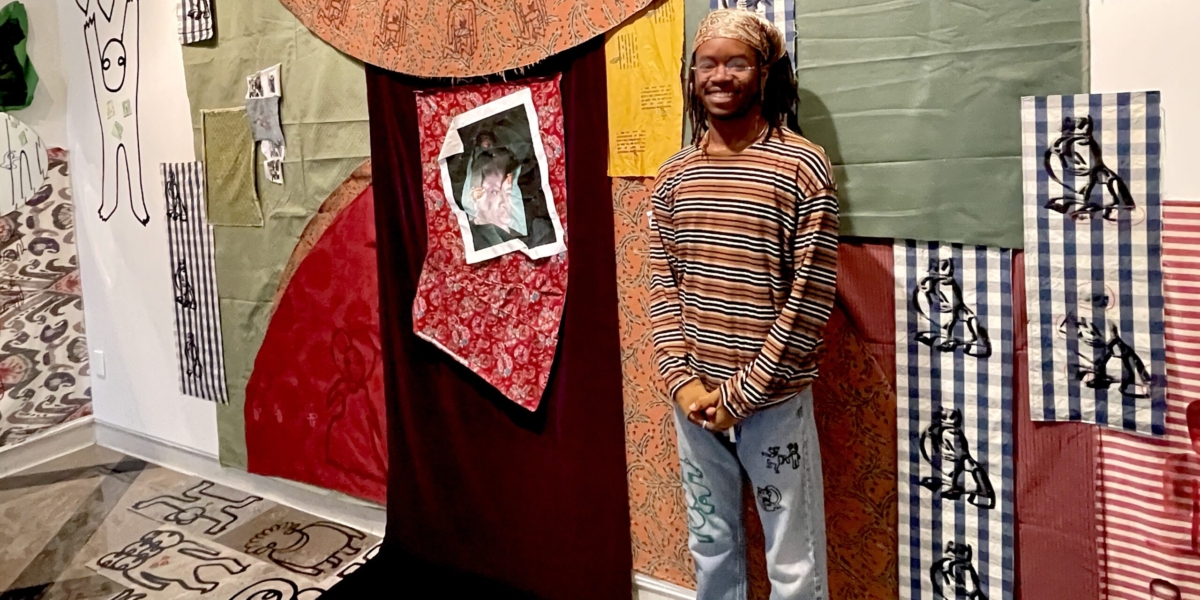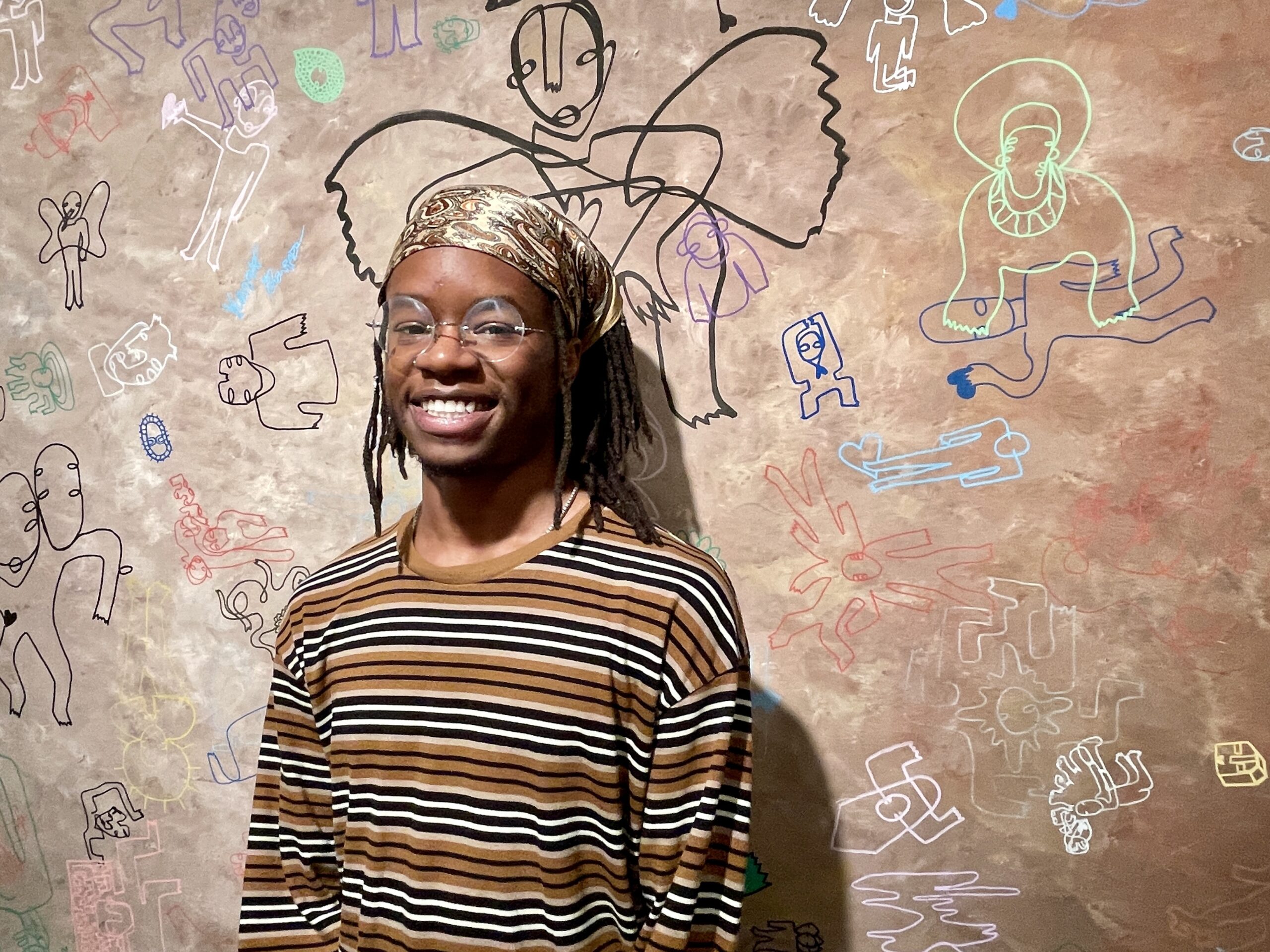
Karim Gavins ’20 transforms Alumni Artist Residency experience into ‘Finding Karim’
Wednesday, September 4th, 2024
Curiosity drove Karim Gavins ’20 to apply for PCA&D’s Alumni Artist Residency, and the result stretched not only their creative practice, but also the way in which their art impacts their everyday life:
Giving new purpose to found materials. Using art as a means of maintaining health and exploring the relationship they have with the world. Exploring new facets of human connection. The Artist Residency gave Gavins, whose BFA degree was in Photography & Video, the time and space to more fully explore it all.
The result, an immersive Finding Karim, fills multiple levels of the College’s Main Gallery through Oct. 4. A reception for Gavins will be part of the Sept. 6 First Friday celebrations, from 5-8 pm. Visitors throughout the run of the exhibition can become part of the Finding Karim experience by joining the show using a custom Snapchat filter (it opens in mobile even if you don’t have the app: https://tinyurl.com/FindingKarimFilter)
The residency and its culminating exhibition, Gavins said, “feels like my official declaration combating a version of myself that thought I needed to be or create a certain way. This experience of having time to focus on art has given me time to focus on myself and what I need to do to keep making the best art I can.”
Dive more in depth into Gavins’ artistic transformation, and learn where Finding Karim will take them next:
What motivated you to apply for the artist residency?
Karim Gavins: I was highly curious in what the current students were making and how they were using art in their lives. I’m also very familiar with all the equipment and the literal building of PCA&D, which plays a huge role in my art-making as I like to be as comfortable as possible. When I was a student here, I got to see Maria Dumlao’s work as well as “Butterfly Effect” by Ana Vizcarra Rankin, and seeing how those artists use the space the way they did really inspired me to want to come back and add to that conversation. I’ll take any opportunity I can to focus on art.
We can see some throughline from your senior thesis work — the photography and the use of mixed media — what has evolved in your work since graduation?
KG: I think being in school, you are often faced with prompts to help guide you through learning new techniques and ideas. Once I no longer had that, I found that needed to create my own “prompts” and guidelines for not just what I wanted to make, but how I wanted to make it. Once I wasn’t around majority photography it really helped me push through the limitations of individual mediums and to create in ways that were fully accessible to me. Working as a photo editor at a photo studio I saw a lot of leftover props, fabrics, and things in general that no longer had a purpose there, so I sought to give them one. Majority of my show outside of the paper used to print images was sourced from my job’s throw-away piles. No longer being in school, it becomes up to you to supply yourself with inspiration! When I was in school and in that stage of life, I felt a high pressure to perform and using/running from that feeling is what drove me to want to make art. I think my art practice has changed a lot, mainly that my practice now focuses on using art as a method of staying healthy and maintaining that health. The art that gets shared to the world comes as a byproduct of a healthy and loving relationship I have with art, myself, and the world. There’s a lot of balancing but I think that’s the point.

Can you explain the theme that ties together this exhibition? What were you influenced by?
KG: The main theme for this exhibition, in my eyes, is narrative through acts of love and devotion. I love art and what it has done for my life. It’s given me a place to exist beyond space and time. Art’s presence/experiences have shown me ways of human connection I have never noticed before. Out of my love for art I find a lot of energy and purpose, I decide to channel that mostly back towards art itself and then towards the world. “all about love” by bell hooks became a big inspiration for me to work at building more meaningful relationships with the things I love and figuring out what does love means to us as humans and how does it look through me. The content of the drawings/prints comes from various media (TV shows, movies, music), people I meet, and things I encounter in my everyday life.
The main driving force behind them all is mythology, more specifically creation mythology. Without diving too deep the main stories I’ve been reading and listening to are the Popol Vuh (mythology of K’iche people), Avalokiteshvara (Buddhism), Guanyin (Chinese) and some ancient Egyptian mythology as well as the Greek pantheon. I’ve also been playing The Binding of Isaac and watching a lot of Evangelion lately. The font choice for the “Finding Karim” is a reference to the legendary text work within the Evangelion series.
What has been the challenge of this experience? What has been the most rewarding aspect?
KG: I’m used to thinking about art as a perfectionist, like things should be a certain way, instead of things could be a certain way. This feels like my official declaration combating a version of myself that thought I needed to be or create a certain way. This experience of having time to focus on art has given me time to focus on myself and what I need to do to keep making the best art I can. By choosing to operate out of love towards myself I’ve been able to transfer that into my art. The most rewarding aspect is feeling like I’ve found a way to balance myself for a healthier life and that I can share that through the art.
Film vs. digital: Which is your preference and why?
KG: I don’t have a general preference! I think like any medium they both are tools for me to filter ideas through, and depending on the idea will depend on the tool I choose. I like to use film when I need an image to feel as “true” as possible. I think film has a spectacular ability to capture light/shadows at their highest qualities. The process of using film also forces me personally to slow down being as you don’t have unlimited shots (unless you have unlimited money, FILM IS EXPENSIVE). I use digital way more because of its quick turn-around and it’s very easy to manipulate. Digital works best for my art-making process but film definitely feels better to look at to me.
What artistic project(s) are you working on now?
KG: I’m currently focusing on making clothing and LOTS more screen printing. I love to print on clothing so people can be a part of the art. I have no new exhibitions planned but I loved this installation process so much it’s getting me super excited to show more!
What Instagram and/or website would you like us to direct people to?
KG: karimgavins.com and my Instagram is @wheres.karim.
